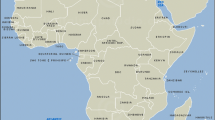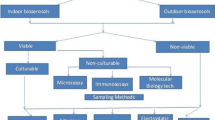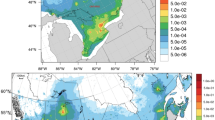Abstract
Five higher Chlorinated Benzenes (CBs), include Hexachlorobenzene (HCB), pentachlorobenzene (PeCB) and three isomers of tetrachlorobenzens, were analyzed in 20 outdoor dust samples collected from a fast developing city, Xinxiang. Only HCB was detected in all outdoor dust samples. The dominate part of the CBs residue in most samples was HCB and the mean HCB concentration (4.13 ng/g dry weight) in this study was in the range of global background soil HCB levels (ranging from 0.010 to 5.20 ng/g dry weight). The higher ratios of HCB/PeCB in the outdoor dust samples in the present study indicate that pesticide application may be an important source of HCB in China.


Similar content being viewed by others
References
Bailey RE (2001) Global hexachlorobenzene emissions. Chemosphere 43:167–182
Bailey RE (2007) Pentachlorobenzene—sources, environmental fate and risk characterization. http://www.eurochlor.org/upload/documents/document260.pdf. Accessed 18 Aug 2010
Barber JL, Sweetman AJ, Wijk D, Jones KC (2005) Hexachlorobenzene in the global environment: emissions levels, distribution, trends and processes. Sci Total Environ 349:1–44
Covaci A, Manirakiza P, Schepens P (2002) Persistent organochlorine pollutants in soils from Belgium, Italy, Greece, and Romania. Bull Environ Contam Toxicol 68:97–103
Dai TY, Zhu XH, Meng W, Yu YJ, Wang W, Li FS, Liu F, Yang YL, Wu DN (2008) Could gingko foliage serve as a bio-monitor for organochlorine pesticides in air. Sci China Ser B Chem 51:1093–1101
Fu S, Li K, Yang Z, Xu XB (2008) Contamination status of hexachlorobenzene (HCB) in sandstorm depositions from Beijing and the origination region. Bull Environ Contam Toxicol 81:196–199
Greenpeace Research Laboratories (GRL) (2001) The presence of brominated flame retardants and organotin compounds in dusts collected from Parliament buildings from eight countries. http://www.archive.greenpeace.org/toxics/reports/eudust.pdf. Accessed 18 Aug 2010
Meijer SN, Ockenden WA, Sweetman A, Breivik K, Grimalt JO, Jones KC (2003) Global distribution and budget of PCBs and HCB in background surface soils: implications or sources and environmental processes. Environ Sci Technol 37:667–672
Oh JE, Gullett B, Ryan S, Touati A (2007) Mechanistic relationships among PCDDs/Fs, PCNs, PAHs, CIPhs, and CIBzs in municipal waste incineration. Environ Sci Technol 41:4705–4710
Roots O, Roose A, Kull A, Holoubek I, Cupr P, Klanova J (2010) Distribution pattern of PCBs, HCB and PeCB using passive air and soil sampling in Estonia. Environ Sci Pollut Res 17:740–749
USEPA (1998) Memorandum 2/26/98 assessment of the dietary cancer risk of hexachlorobenzene and pentachlorobenzene as impurities in chlorothalonil, PCNB, picloram, and several other pesticides. DP Barcode D243499. Chemical codes 061001 (Hexachlorobenzene) & 081901 (Chlorothalonil). http://www.epa.gov/oppsrrd1/reregistration/endosulfan/hexachlorobenzene_endo.PDF. Accessed 2 Oct 2007
Wang G, Lu YL, Han JY, Luo W, Shi YJ, Wang TY, Sun YM (2010) Hexachlorobenzene sources, levels and human exposure in the environment of China. Environ Int 36:122–130
Weber R, Gaus C, Tysklind M, Johnston P, Forter M, Hollert H, Heinisch E, Holoubek I, Lloyd-Smith M, Masunaga S, Moccarelli P, Santillo D, Seike N, Symons R, Torres J, Verta M, Varbelow G, Vijgen J, Watson A, Costner P, Wölz J, Wycisk P, Zennegg M (2008) Dioxin- and POP-contaminated sites—contemporary and future relevance and challenges. Environ Sci Pollut Res 15:293–363
World Health Organization-International Programme on Chemical Safety (WHO-IPCS) (1997) Hexachlorobenzene, environmental health criteria 195. World Health Orgaization, Geneva, Switzerland. http://www.inchem.org/documents/ehc/ehc/ehc195.htm. Accessed 18 Aug 2010
Zhou X, Yu G, Huang J, Zhang ZL, Hu HY (2007) Residues and distribution characters of chlorobenzenes in soil and plants from Beijing southeast chemical industry zone (in Chinese). Environ Sci 28:249–254
Acknowledgments
This study was financially supported by the Scientific Research Start-up Foundation of Xinxiang Medical University.
Author information
Authors and Affiliations
Corresponding author
Rights and permissions
About this article
Cite this article
Yang, ZZ., Li, YF., Li, ZC. et al. Distribution and Characterization of Higher Chlorinated Benzenes in Outdoor Dust Collected from a Fast Developing City in North China. Bull Environ Contam Toxicol 86, 38–42 (2011). https://doi.org/10.1007/s00128-010-0179-6
Received:
Accepted:
Published:
Issue Date:
DOI: https://doi.org/10.1007/s00128-010-0179-6




